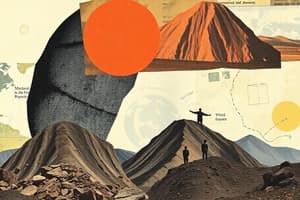Podcast
Questions and Answers
What type of elements are lithophiles primarily associated with?
What type of elements are lithophiles primarily associated with?
- Gases in the atmosphere
- Silicates (correct)
- Native metals in the core
- Sulfides
Which classification describes elements that are found as native metals in the core?
Which classification describes elements that are found as native metals in the core?
- Atmophile
- Siderophile (correct)
- Lithophile
- Chalcophile
What term refers to the limitations imposed by the distribution of chemical elements in the Earth's crust on metal supply?
What term refers to the limitations imposed by the distribution of chemical elements in the Earth's crust on metal supply?
- Sustainability of deposits
- Mineralogical barrier (correct)
- Geochemical scarcity
- Critical metals list
Which metals are considered geochemically scarce?
Which metals are considered geochemically scarce?
Who proposed the concept of the 'mineralogical barrier'?
Who proposed the concept of the 'mineralogical barrier'?
Why is technological innovation crucial for mining geochemically scarce metals?
Why is technological innovation crucial for mining geochemically scarce metals?
What type of metals are typically mined as major elements in ore forming minerals?
What type of metals are typically mined as major elements in ore forming minerals?
What is the main focus of the critical metals list?
What is the main focus of the critical metals list?
What characterizes a mineral deposit?
What characterizes a mineral deposit?
What distinguishes metallic ore deposits from non-metallic deposits?
What distinguishes metallic ore deposits from non-metallic deposits?
What defines a mineral resource?
What defines a mineral resource?
What is the difference between mineral resources and mineral reserves?
What is the difference between mineral resources and mineral reserves?
What is the term for ore deposits that form at the same time as their host rocks?
What is the term for ore deposits that form at the same time as their host rocks?
What role does a registered 'competent person' play in mineral resource evaluation?
What role does a registered 'competent person' play in mineral resource evaluation?
Which type of mineralization is caused by ascending hydrothermal solutions?
Which type of mineralization is caused by ascending hydrothermal solutions?
At what depth do epithermal deposits typically form?
At what depth do epithermal deposits typically form?
What are siderophile elements, and how do they relate to the Earth's crust?
What are siderophile elements, and how do they relate to the Earth's crust?
Which of the following statements is true regarding fossil fuels?
Which of the following statements is true regarding fossil fuels?
Which of the following is NOT one of the four basic requirements for ore deposit formation?
Which of the following is NOT one of the four basic requirements for ore deposit formation?
In the context of mineral deposits, what is the significance of atom fraction?
In the context of mineral deposits, what is the significance of atom fraction?
What characterizes mesothermal deposits?
What characterizes mesothermal deposits?
Which term describes a deposit of sand or gravel containing valuable minerals?
Which term describes a deposit of sand or gravel containing valuable minerals?
Which geological factor is NOT considered in more complex ore classification?
Which geological factor is NOT considered in more complex ore classification?
What process allows ore deposits to be preserved?
What process allows ore deposits to be preserved?
Flashcards are hidden until you start studying
Study Notes
Mineral Deposits
- A mineral deposit is a concentration of economically valuable minerals within the Earth's crust that is feasible to extract.
- Metallic ore deposits are mined for valuable metals, such as gold, platinum, copper, lead, zinc, and nickel.
- Non-metallic deposits, or industrial minerals, are mined for their physical properties or chemical content, including salt, phosphate, gravel, and dimension stone.
- Energy resources like nuclear energy and fossil fuels (coal, oil, and gas) are not defined as minerals.
Mineral Resources and Reserves
- A mineral resource is any concentration of minerals of economic interest, regardless of their feasibility for extraction.
- A mineral reserve is a proven and quantified portion of a mineral resource that is economically viable to extract.
- Mineral reserves are estimated through detailed geological evaluations, including drilling and geophysical testing, to determine the quantity and quality of the deposit.
- Legal implications surround the terminology of mineral resources and reserves, and these assessments must be conducted by qualified personnel.
Relative Abundance of Metals
- The abundance of elements in Earth's upper continental crust varies greatly, and the rarest elements are often the most dense.
- The Goldschmidt classification categorizes elements based on their affinity for different geological environments:
- Lithophile: associated with silicates and concentrated in the crust.
- Chalcophile: associated with sulfides.
- Siderophile: occur as native metals and concentrated in the core.
- Atmophile: occur as gases in the atmosphere.
Sustainability of Mineral Deposits
- Geochemically abundant metals are found in major rock-forming minerals, and current mining focuses on high-grade ores.
- Geochemically scarce metals are often found as substitutes for major elements in rock-forming minerals, resulting in lower-grade ores.
- "The mineralogical barrier" refers to the technological challenges associated with extracting these scarce metals from lower-grade ores.
- Technological innovation is crucial for the sustainable exploitation of such scarce metals.
Ore Deposit Terminology
- Ore: Naturally occurring material from which a mineral or aggregate can be profitably extracted.
- Syngenetic: Ore deposits that form simultaneously with their host rocks.
- Epigenetic: Ore deposits that form after their host rocks.
- Hypogene: Mineralization caused by ascending hydrothermal solutions.
- Supergene: Mineralization caused by descending solutions.
- Epithermal: Hydrothermal deposits formed at shallow depths (< 1500m) and low temperatures (50-200°C).
- Mesothermal: Hydrothermal deposits formed at intermediate depths (1500-4500 m) and temperatures (200-400°C).
- Hydrothermal: Hydrothermal deposits formed at substantial depths (> 4500m) and elevated temperatures (400-600°C).
- Placer: A deposit of sand or gravel containing particles of valuable minerals.
Formation of Ore Deposits
- Four essential requirements for ore deposit formation:
- A source of ore components (metals and ligands).
- A mechanism for transporting ore components to the deposit site.
- A depositional mechanism (trap) to fix the components as minerals.
- Geological processes to preserve the ore deposit.
Ore Classification Systems
- Ore classification systems are used to categorize and understand ore deposits based on factors such as:
- Composition of the deposit.
- Form of the deposit: size, shape, orientation, and mineralization distribution.
- Associated host rocks or geological structures (ore associations).
- Interpreted genesis of the deposit (processes and controls).
Studying That Suits You
Use AI to generate personalized quizzes and flashcards to suit your learning preferences.




